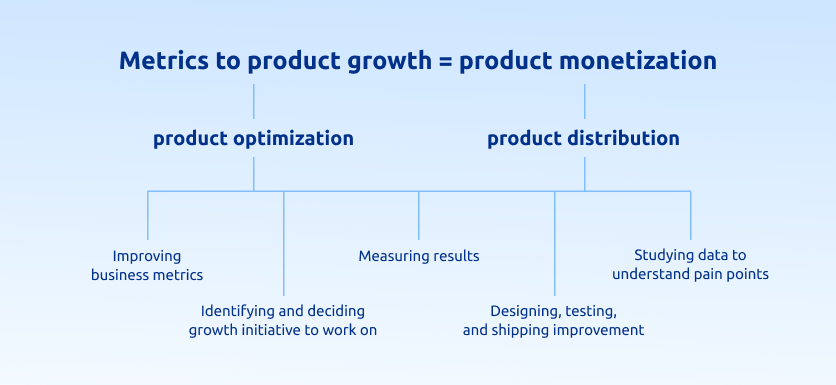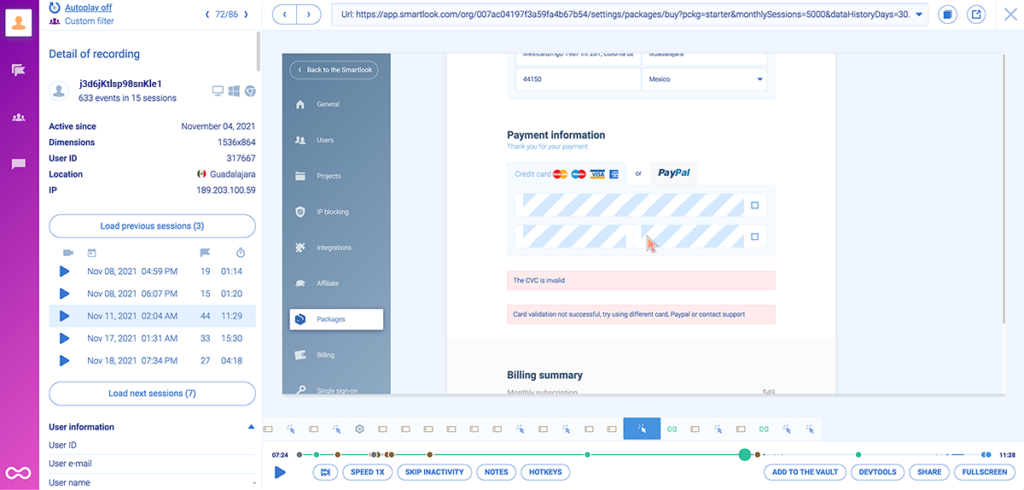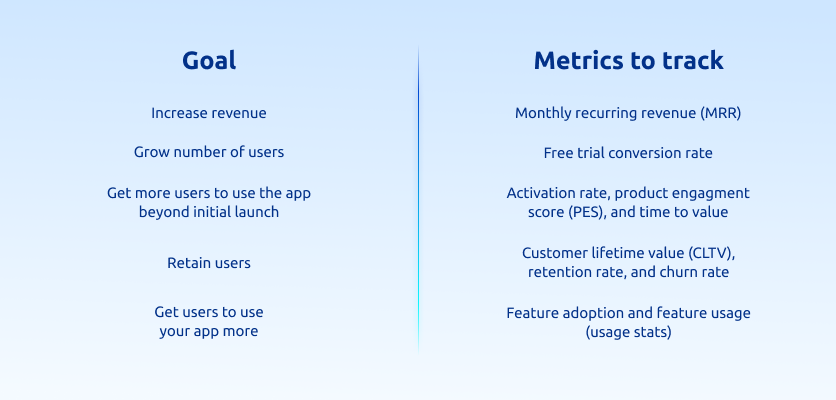Here’s the thing: no matter how good your product is, your target audience won’t use it.
…Unless you optimize and distribute it as an experience that will compel them to continue wanting to use it.
The harsh truth is there are over 3.59 million apps to choose from in the Apple store and another 2.33 million available on Google Play.
In short, offering a solid product alone isn’t enough to stand out from the competition. Sure, you’ve checked off a foundational requirement, but you also need to work on improving distribution.
This is where product growth with a focus on driving measurable business outcomes comes into play.
The question that remains is who and what is involved in product growth, and how do you go about successfully encouraging the growth of your product?
Throughout this product growth guide, we’ll provide you with answers to these questions and more. By the end, you’ll know how to create a product growth strategy, including which tools will help you along the way.
- What is product growth?
- What’s involved in product growth?
- Who’s involved in product growth?
- The importance of product growth
- Core principles for creating a winning product growth strategy
- How to create a product growth strategy
What is product growth?
Product growth refers to identifying and taking advantage of opportunities to improve your product’s value, including how to get customers to use it as often as possible.
Put simply, product growth aims to improve product usage to drive quantifiable business outcomes like increased revenue.
Keep in mind that product growth is not the same as product-led growth or PLG (where the product drives customer acquisition) and product strategy (a plan of action geared toward product development).
That said, It does share some similarities with product growth management. However, there’s a lot more under the product growth umbrella than that which falls under traditional product management. Let’s take a look at what falls under product growth.
What’s involved in product growth?

Product growth focuses on:
- Optimizing and distributing your product(s)
- Driving measurable business outcomes
To this end, growth product teams work on the following:
- Improving business metrics throughout the user funnel. This involves optimizing every step in the user journey, including customer acquisition, retention, and expansion
- Identifying and deciding which growth initiatives drive the most business impact
- Improvements related to design, testing, and shipping while measuring the results
What your growth product manager does depends on your growth goals.
For instance, product growth leaders launching new features will work on tasks like ideating, testing, and reviewing new feature adoption. Conversely, a product growth team that’s dedicated to getting your customers to use more of your product will focus on activities like reducing friction in user paths and quickly resolving bugs and crashes.
Who’s involved in product growth?
Product growth is led by cross-functional teams.
Not only do the product team and growth team work together, but people from design, engineering, marketing, data analysis, and sales teams come together alongside stakeholders like CEOs and CPOs.
Remember, a growth manager doesn’t replace a product manager ❌
Instead, the two work side-by-side as product growth and product marketing are separate functions. That said, in small teams, a product manager can take on the responsibilities of a growth PM with access to non-dedicated, cross-functional resources.
However, John Egan, Pinterest’s Senior Director of Engineering, recommends creating a separate growth team:
The importance of product growth
Now that you know what product growth is, let’s walk you through how important it is for product-led companies:
- Product growth directly increases revenue
It does so by identifying data-backed opportunities to improve your product’s value and the user experience, including retaining users, acquiring new ones, and so on.
- It optimizes and helps distribute your product
A good product alone isn’t enough to retain users, acquire new customers, and drive business outcomes. Product growth focuses on driving business success by optimizing and distributing your product better.
- It saves you from revenue leakage
Product growth reviews the entire user lifecycle — from user onboarding and activation to where and how users experience product value and moments of joy — to determine where you could potentially be losing users. In turn, this prevents funnel leakage and helps build a loyal customer base.
Core principles for a winning product growth strategy
Although it’s clear that growth initiatives drive product monetization, a product growth strategy can’t deliver measurable results until it adheres to the following four core principles. Think of them as the foundational pillars that drive product growth:
1. Cross-collaboration is at the heart of successful product growth
Product growth is multi-disciplinary — no one or two teams can work on it in isolation. Instead, multiple teams, from design to engineering and marketing teams, contribute to driving growth.In fact, when we asked experts for recommendations regarding product growth success, Max Benz, Founder and CEO at BankingGeek, recommended cross-collaboration.
Keep in mind you’ll need to choose product growth tools that support cross-collaboration. For instance, Smartlook encourages cross-team coordination by allowing teams to review session recordings that show in-app user activity. This way, all teams can participate in the product analytics process.
2. Experimenting and testing are central to product growth
Having an experimental mindset is one of the most crucial product management skills.
“My biggest recommendation when it comes to product growth is experimentation — don’t be afraid to try new ideas! Experiment often but measure your results so you can quickly learn what works best for your particular audience,” shares Lisa Dietrich, Partner at Girokonto.
This is why prototyping, A/B testing, and gathering and analyzing quantitative and qualitative data are essential to product growth.
Smartlook enables you to combine four main quantitative and qualitative analytics features (session recordings, events, funnels, and heatmaps).
This makes it an ideal tool for fast-growing, fast-building teams that want quick access to visual user insights and product analytics insights without having to dedicate countless hours of time and engineering resources.
3. Data drives product growth decision making
Product growth thrives on in-depth product analytics that reveal details relating to product usage.
Simply put, learning how users interact with your product is essential for identifying where you can improve your product’s value and customer experience and where you can plug revenue leakage.
Consider reviewing the following:
- User paths and funnels to identify where users are dropping off
- Session recordings to find out where users are getting stuck and how often they’re hitting roadblocks
- Heatmaps to understand which elements or buttons users click and how far they’re scrolling in your SaaS app
4. In-depth customer and product understanding leads to effective product growth
Product growth is incomplete without a deep understanding of user psychology and your target users in particular.
Smartlook makes it easy to get the in-depth scoop regarding user in-product pain points, including how they move throughout your product and engage with specific features.For example, session recordings provide you with a detailed replay of how users interact with your product (the steps they take and where they struggle).

Events allow you to visualize user actions, including the buttons in-app users click, the text they type, and the screens they visit.
Vojtěch Šibor, Smartlook’s Product Marketing Manager, recommends using events to track “which feature is the most used and which one is the least used. Based on what you learn, decide whether to develop the most used one more or improve onboarding on the unused feature.”

That said, it’s important to understand your product, including how it makes your target audience’s lives easier. As Nadeem Ballaj, Founder & CEO of SeeBiz, puts it: “[It’s essential] to have a clear understanding of your product’s value proposition and be able to communicate it to your target market.”
How to create a product growth strategy
To be able to drive measurable results from product growth, start by developing a data-driven business growth strategy.
Essentially, a product growth strategy is an actionable, time-bound blueprint to optimize your product and increase business revenue.
This strategy ensures your product growth plan follows a defined focus within a predetermined timeframe — both of which are essential prerequisites to driving quantifiable business results. It’s also useful for convincing stakeholders to buy in and for gaining the resources you need to grow.
Your product growth strategy should cover the following:
- Goal: what objectives do you want to achieve?
- People: who will be impacted by this goal?
- Product: how will your product help achieve this goal?
- Tactics: what are the exact steps you’ll take to achieve your goal(s)
With that, let’s look at creating a product growth strategy that answers these four questions:
Step 1: Determine the goals of your strategy
Your growth strategy goals should reflect your product and business goals. That’s why it’s important to begin by reviewing your business objectives, product strategy, and roadmap with your stakeholders and product team.
At the end of the day, you’ll find that your strategy’s goals will fall under 1 or 2 of the following categories:
- Growing into a new market (market expansion)
- Expanding to encompass a new user base
- Creating new in-demand products or features
- Growing product usage (encouraging current users to frequently use more of your product)
While you’re at it, collaborate with your product team to learn about user pain points and the value that your product currently offers. This will help you identify business struggles that you may be facing, such as:
- A poor activation rate — users are interested in trying your product, but it takes them too long to achieve the first milestone or ‘aha’ moment, which reduces interest
- Problems retaining current users — paying customers are churning for reasons like poor product experience
- High customer acquisition costs (CAC) — your current strategy to acquire new customers is working, but it’s too costly
- Leaky bucket — you’re losing users somewhere b/w your mobile and website devices
Step 2: Gather product experience data
Besides getting information from your product team relating to product struggles, dive into product experience analytics yourself. This will give you firsthand data that will help you determine:
- Which features are the most popular
- Where your users are struggling
- How well they’ve adopted your product
“Use [this] data to drive decision-making and identify patterns and trends that can inform your growth strategy,” says Nadeem Ballaj of SeeBiz.
Here’s how:
- Track your daily, weekly, and monthly active users in your Smartlook dashboard
This will help you understand product stickiness, including the number of people who are signing up for your tool and actually using it.
- Study user paths and visualize the user journey
Smartlook’s funnels show you exactly how users move from one step to the next within your product.
Funnels also show how many folks complete the workflows you’ve designed for them, helping you better understand their product experience and struggles.
- Review product stability by identifying bugs and crashes
This is important for offering your users an excellent product experience. You can identify such issues by tracking Crash Reports in Smartlook. Vojtěch explains that these reports “mainly show you a recording of where and how [a crash or bug] happened, which makes it simple for you to spot and fix them.”
- Track user retention using retention tables in Smartlook
The plan here is to determine whether users are leaving immediately, after a while, or if they’ve stopped using a core feature. With Smartlook’s retention tables, you can easily understand this data.
The tables below show a group of users who visited your product for the first time within a specific timeframe. Next, you’ll see that particular cohort’s activity over time, such as their progressive ‘drop-off’ rate.
Dive deeper: How to measure product adoption
All this data tells you how to improve product growth strategies and helps inform decision-making regarding which growth initiatives to pursue. For instance, it tells you if you should focus on offering more value, creating new features, or if you need to refine your existing product.
Step 3: Create an action plan
By the end of the first step, you’ll have a goal for your product growth strategy, a list of business struggles and user pain points, and a data-backed plan for which growth initiatives to focus on.
In this step, highlight the tactics you’ll use to solve these concerns. Ask yourself what growth tactics you can leverage to achieve your goals.
You don’t need a solid list of tactics to follow at this point. Experimentation is a core product growth principle, so be sure to test ideas before dedicating more resources.
This way, your ideal workflow will look something like this:
- Define problems based on the data you review
- Ideate and prototype solutions
- A/B test with users
- Choose a solution to launch

Leading product-led companies like Amazon follow this approach. Dubbed the “backwards approach,” Plainly’s Co-founder, Nebojsa Savicic, shares how it works: “Customers are involved in the creation of new products or features. Amazon saves a lot of time and money before officially beginning the product cycle by testing reactions (for example, through mock press releases) before actually creating products.”
The good news? Smartlook can help you test any new solutions you wish to release.
For instance, if you launch or refine features, you can watch session recordings of real user samples to measure feature adoption. Study these recordings to spot friction regarding the use of new and refined features. For example, you may learn that users are spending a considerable amount of time locating a new feature or completing the flow.

You can also create custom in-app events in Smartlook to collect statistics regarding how many users follow any new paths you’ve designed for them.
Step 4: Getting stakeholders to buy in
Next comes a dreaded but crucial step — getting stakeholders’ approval. Luckily, the following playbook makes things easy:
- Identify who the target stakeholder is
- Understand what’s important to them
- Speak their language
The most convincing aspect? Collate data from screen recordings and direct customer feedback into a visualized presentation (like a bite-sized movie showcasing user struggles) to make your case.
Smartlook makes this easy thanks to integration with Survicate. In short, Survicate lets you gather customer feedback using microsurveys. The results are then displayed in your Smartlook dashboard, where you can watch session recordings of respondents sharing complaints to get a better idea of what they’re struggling with.
As Smartlook’s Vojtěch Šibor writes, “by combining surveys and session recordings, you can detect problems in the product from people who have directly complained or have low NPS.”
Step 5: Put together a team
Even if you have a separate growth team, you need to take the time to allot responsibilities. So make sure you answer the following:
- Who will be involved?
- What will their roles be, and what will they work on?
- What resources will they need to get the job done?
Step 6: Create a strategy timeline
Next, turn your entire plan into an actionable blueprint. You can do this by thoughtfully dividing your plan into phases and then identifying which tasks are involved in each.
With your phases and tasks in place, create a timeline for each phase and, by extension, a strategy. This way, you’ll have a timeline for how long each phase will take and, as a result, how long it will take to execute your strategy and achieve your goals.
Be sure to have the following ready:
- Strategy and phase start dates
- Strategy and phase end dates
- Progress check-in/review dates
- Strategy review dates
One last tip: “Don’t be afraid to pivot from your original product design if necessary. Sometimes it’s necessary to change direction in order to achieve growth,” advises Nadeem Ballaj of SeeBiz. That’s why having a strategy review date is essential for evaluating how well your overall plan is doing and if it needs to be altered.
Step 7: Identify which growth metrics you’ll track
Lastly, point out the metrics you’ll track to see your progress. The metrics you choose will be based on the goals you wish to achieve.
Here’s a rundown of which product growth analytics to track based on your goals:

Ready to become a product growth expert?
Before you dive into creating your product growth strategy, make sure to do the following:
- Collaborate with various team members to understand your business, product goals, and struggles
- Gather and analyze quantitative and qualitative data relating to the user experience, including how well they’ve adopted your product
- Test and optimize different growth initiatives to drive measurable business outcomes
Remember, successful product growth thrives on cross-team collaboration, experimentation, and making data-driven decisions.
Thankfully, Smartlook can assist you at each step along the way, helping you understand the user product experience, the steps they take, the buttons they click, and which features they use the most. So what are you waiting for? — request a demo or start your free, full-featured 30-day trial today to drive business growth.











